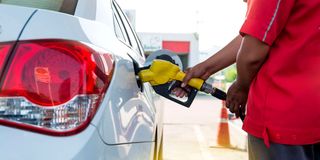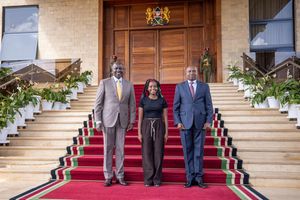Premium
Subsidy helps cut pump prices to lowest in over two years

Falling pump prices are key to reducing inflation as diesel is the main driver of the Kenyan economy.
What you need to know:
- A litre of diesel will retail at Sh164.86 from Sh167.06 next month, while petrol will cost Sh174.63 from Sh176.58 in Nairobi.
- The last time a litre of diesel was cheaper than this was in April 2023 at Sh162 while petrol was at Sh159.12 per litre in August 2022.
Pump prices will fall by as much as Sh2.40 per litre for the April 15-May 14, 2025 review cycle after the State maintained the subsidy regime--bringing prices to their lowest in at least two and a half years.
A litre of diesel will retail at Sh164.86 from Sh167.06 next month, while petrol will cost Sh174.63 from Sh176.58 in Nairobi. The last time a litre of diesel was cheaper than this was in April 2023 at Sh162 while petrol was at Sh159.12 per litre in August 2022.
The fall is linked to a subsidy of Sh6.09 and Sh4.66 per litre of diesel and petrol respectively, as the shipment costs of the two fuels have increased marginally.
“The maximum allowed petroleum pump prices for petrol, diesel and kerosene decrease by Sh1.95 per litre, Sh2.20 per litre and Sh2.40 per litre respectively, Daniel Kiptoo, the director-general of the Energy and Petroleum Regulatory Authority (Epra), said in a notice on Monday afternoon.
The subsidy cuts came as the transport cost of diesel rose by 1.41 percent to $680.63 (Sh88,298.12) per cubic metre last month from $671.14 (Sh87,006.58) for the same quantity in February, while that of petrol rose by 1.34 percent to $637.22 (Sh82,666.55) per cubic metre from $628.80 (Sh81,517.63) for the same quantity in the same period.
However, it is not clear whether the new pump prices are in line with the renegotiated fuel import deal that Kenya agreed with three Gulf oil majors last month.
Petrol and diesel prices had remained unchanged since the beginning of the year despite a strong shilling, leading to increased public scrutiny of the government-backed deal.
Saudi Aramco, Emirates National Oil Company (Enoc) and Abu Dhabi National Oil Company (Adnoc) agreed to reduce premiums to ensure the deal did not deprive Kenyans of the relief of falling global fuel prices.
Under the new deal, which has been extended to March 2028, a tonne of diesel will cost $78 (Sh10,080.72), down 11.3 percent from $88 (Sh11,373), while petrol will cost $84 (Sh10,856) from $90 (Sh11,631). A tonne of kerosene will cost $75 (Sh9,693), down 14 percent from $111.75 (Sh14,442).
In the new prices, which will be in effect until May 14, Epra has reduced the subsidy on diesel from Sh9.90 per litre and that on petrol from Sh6.92 for the same volume.
The prices at which the three Gulf oil majors sell fuel to Kenya and the exchange rate of the shilling against the dollar are the two biggest determinants of pump prices.
Kenya agreed last month to extend the deal with the Gulf oil companies but at lower premiums, setting the stage for lower pump prices unless the shilling weakens drastically against the dollar.
Falling pump prices are key to reducing inflation as diesel is the main driver of the Kenyan economy, with transporters, farmers, power generators and industry using the fuel to run machinery and vehicles.
Inflation has been slowly rising month-on-month and stood at 3.6 percent last month, up from three percent in December last year when pump prices remained unchanged.





